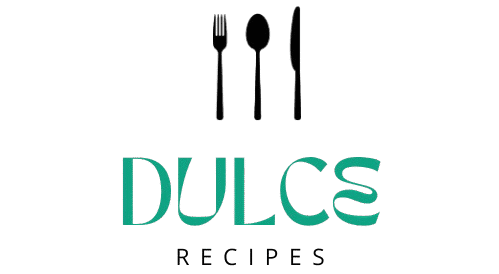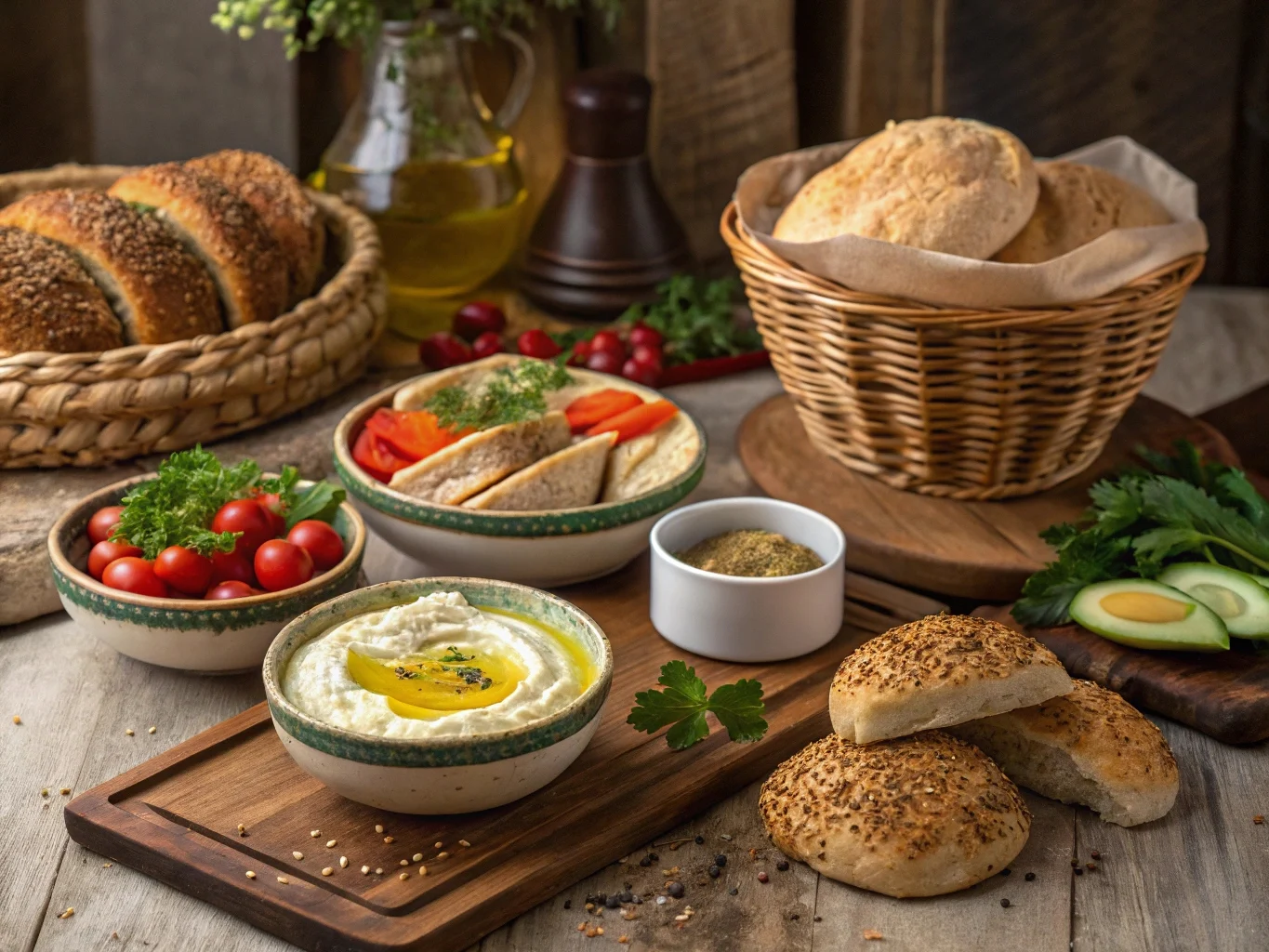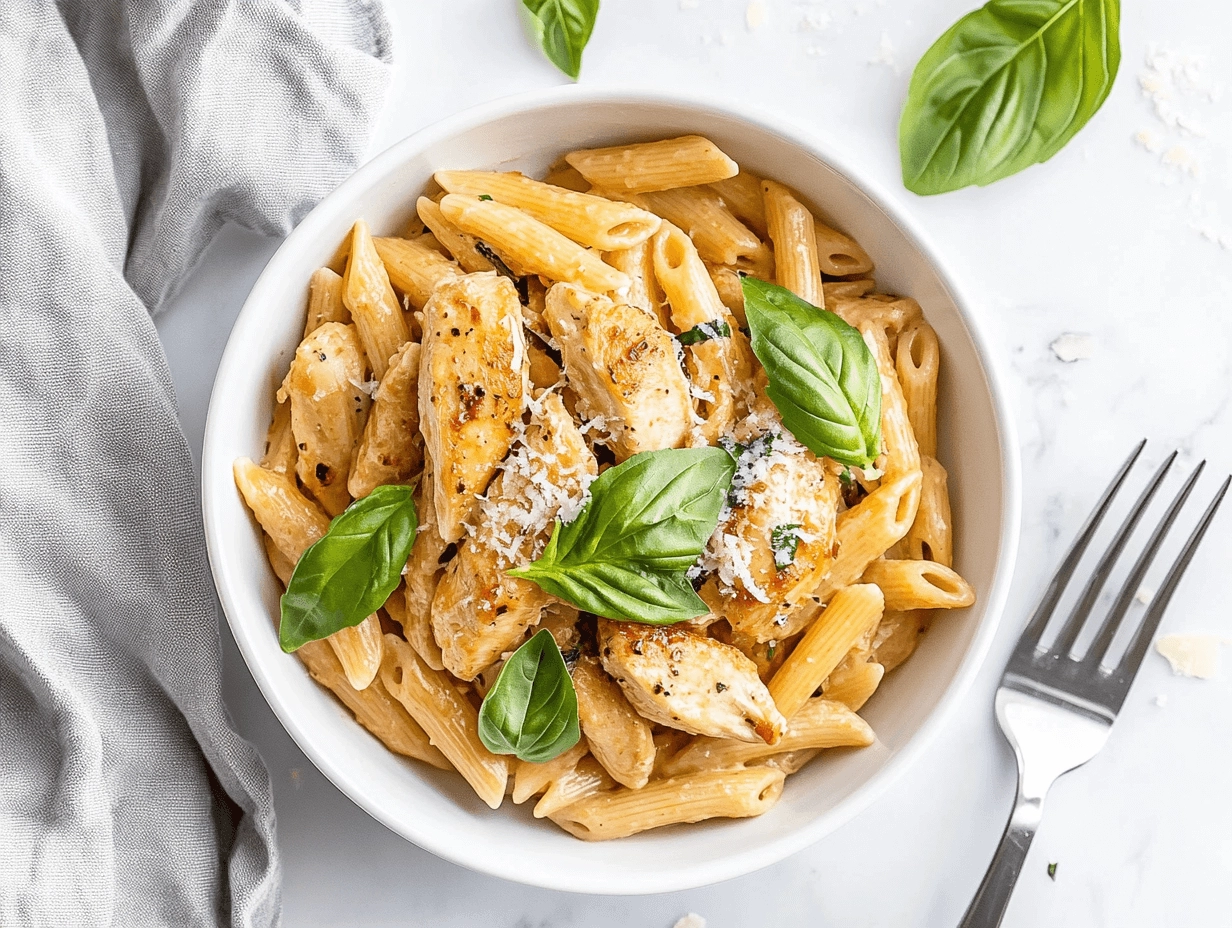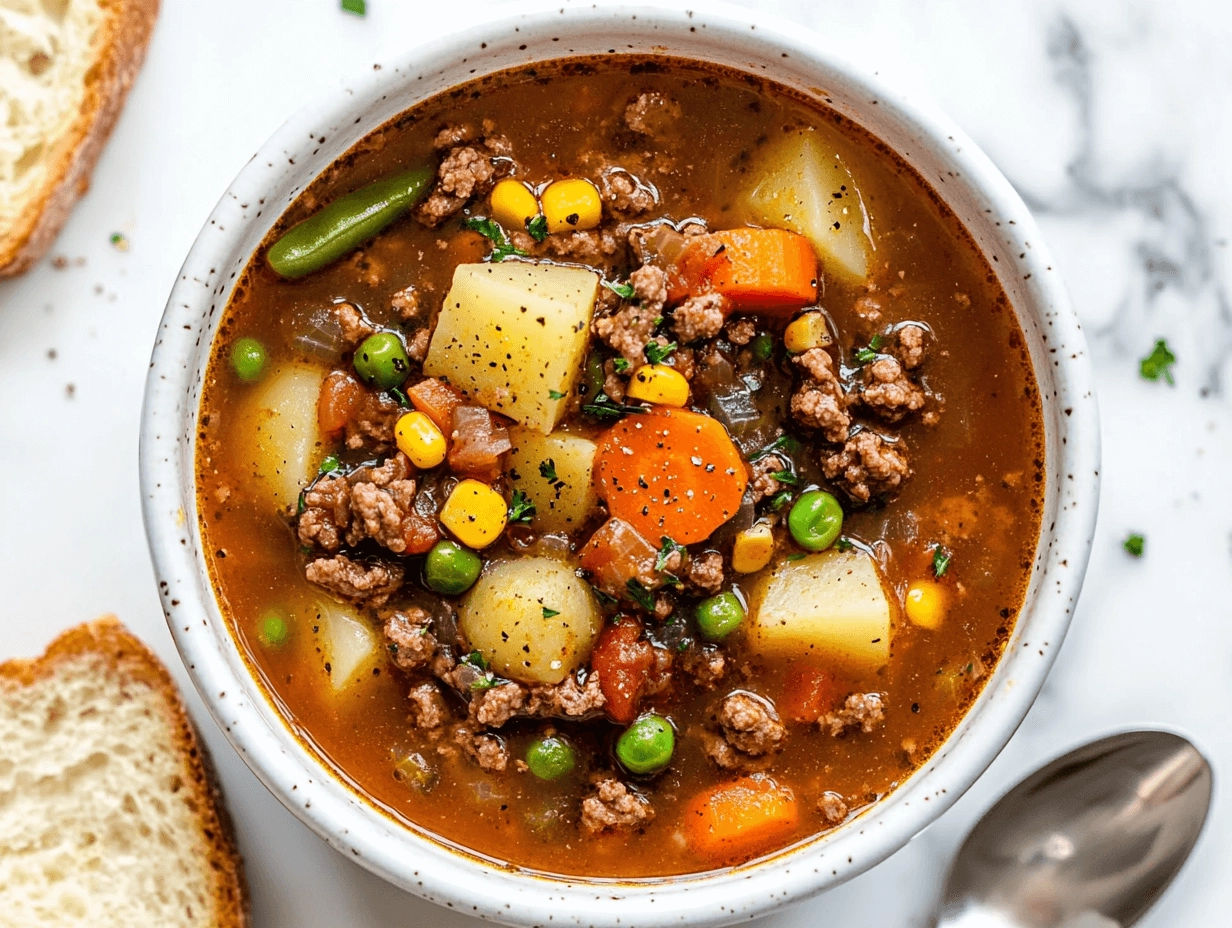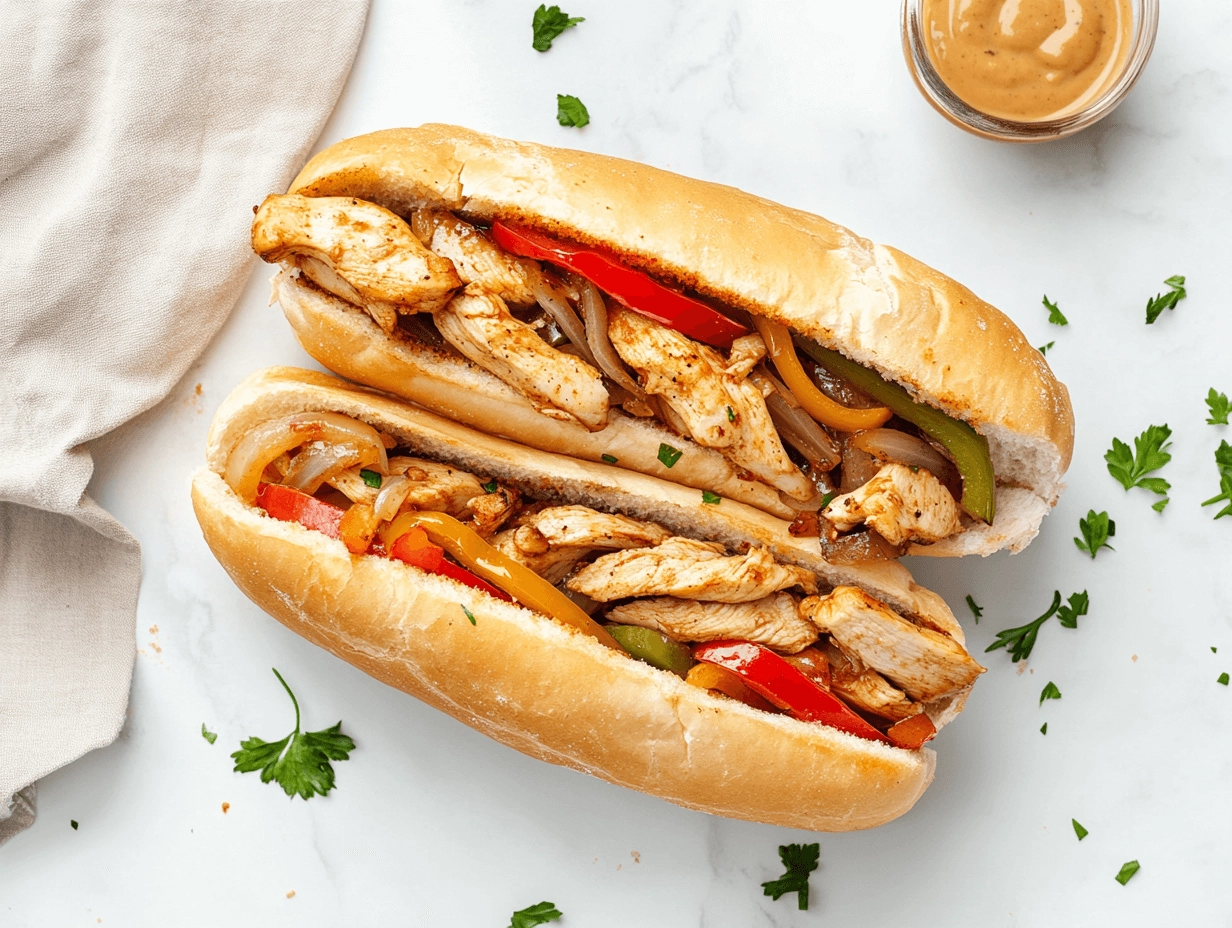Every morning, kitchens in the Middle East buzz with activity. The sizzle of pans and the smell of fresh bread fill the air. Arabic breakfasts are more than just food; they’re a celebration of culture and family.
Arabic breakfasts offer a world of flavors, beyond shawarma and hummus. From Cairo’s streets to Beirut’s kitchens, these meals share stories of tradition and family. Each dish is a piece of history, inviting you to explore the Middle East’s culinary world.
This collection of 20 recipes will show you the variety of Arabic breakfasts. Whether you’re an experienced cook or just starting, these dishes will bring the Middle East’s morning warmth to your home. You’ll find both traditional and modern recipes to try.
Table of Contents
Discover more delicious recipes and ideas by visiting our homepage!
Understanding Traditional Arabic Breakfast Culture
Arabic breakfasts are more than just a meal. They are a time for families and communities to come together. In Middle Eastern homes, breakfast is a special time for sharing and nourishment.
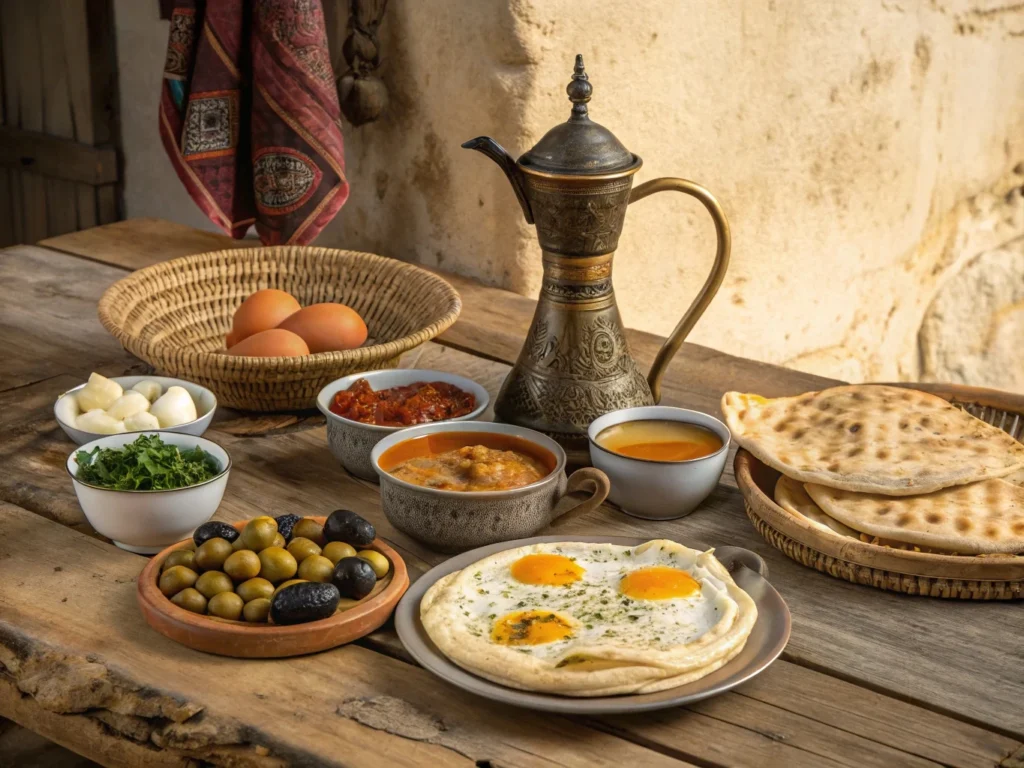
Traditional Arabic breakfasts show the rich culinary heritage of the Arab world. These meals include many mezze-style dishes, making them vibrant and diverse.
The Social Significance of Morning Meals
In Arabic culture, breakfast is a time for families to bond. Studies show that Arabic breakfasts are often shared by 4 to 6 people. This makes the meal a social ritual that fosters connection.
Common Ingredients in Arabic Breakfast Dishes
- Olive oil – rich in heart-healthy monounsaturated fats
- Za’atar – a traditional herb and spice blend
- Tahini – a versatile sesame seed paste
- Fresh vegetables and herbs
- Chickpea-based foods like hummus
Exploring Middle Eastern breakfasts reveals the importance of chickpeas. For example, hummus is packed with protein and fiber. It’s a nutritious choice for breakfast.
Regional Variations Across the Arab World
Arabic breakfasts vary greatly across regions. Lebanese breakfasts might include labneh and manakeesh. North African breakfasts can be spicier. Each region adds its own twist, influenced by local ingredients and traditions.
Essential Arabic Breakfast Bread Varieties
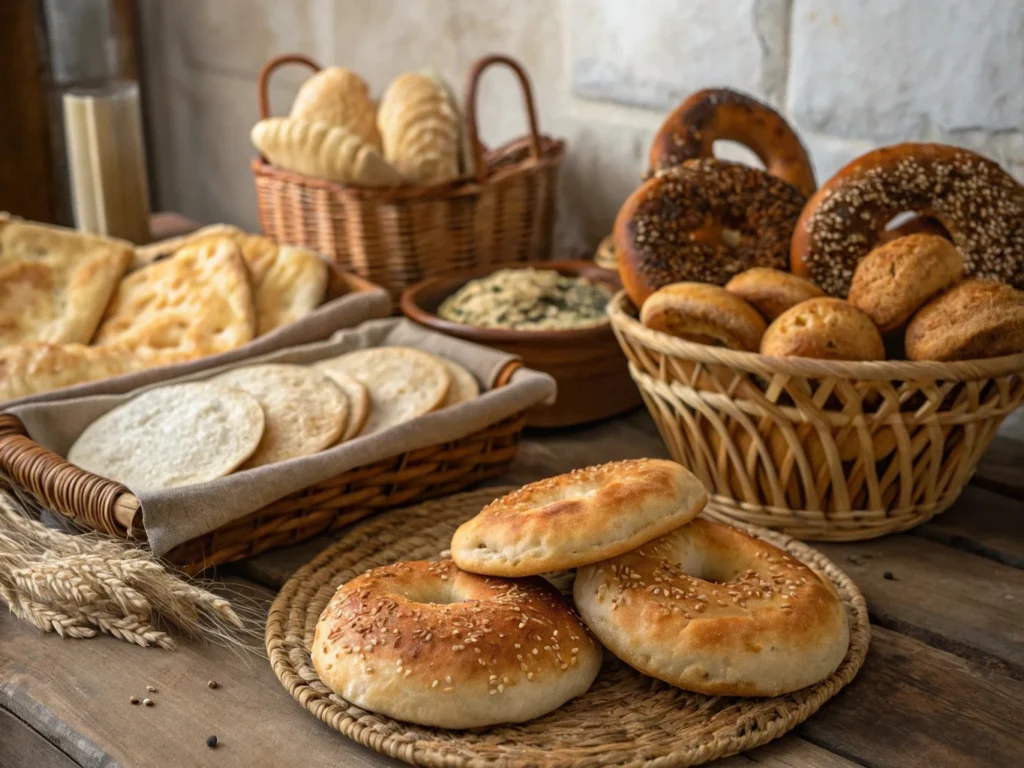
Arabic breakfast breads are the heart of morning meals in the Middle East. They turn simple ingredients into culinary wonders. These breads are key to regional breakfast traditions.
From Beirut’s streets to Damascus’ kitchens, bread is essential. It makes mornings unforgettable.
Now, let’s look at some iconic arabic breakfast breads you’ll love:
- Manakeesh: A flatbread topped with za’atar, often called the Middle Eastern pizza
- Ka’ak: A sesame-studded bread ring loved across the region
- Pita: A round bread great for scooping dips and pairing with dishes
- Aish Baladi: An Egyptian bread with ancient roots, seen as a symbol of life
Each bread has its own story of cultural heritage and culinary innovation. Preparation methods differ by region. Some breads have unique spices like sumac or Aleppo pepper.
Baking temperatures are usually between 450-500°F. This creates crisp outsides and soft insides, making these breads hard to resist.
Whether it’s a weekend breakfast or a quick morning meal, these arabic breads are a tasty way into Middle Eastern cuisine. They’re versatile and pair well with eggs, dips, and morning spreads.
Popular Arabic Breakfast Food Recipes
Discover the vibrant world of arabic breakfast food recipes. They bring Middle Eastern flavors to your morning. From egg dishes to bean preparations, these recipes make breakfast special.

Arabic breakfasts are both healthy and tasty. They showcase the Arab world’s rich culture. Each dish has its own story, reflecting regional traditions.
Classic Arabic Breakfast Egg Dishes
Shakshuka is a favorite arabic egg dish loved worldwide. It’s eggs poached in a spicy tomato sauce. Here’s what makes it special:
- Preparation time: 10 minutes
- Cooking time: 25 minutes
- Serves: 6 people
- Nutritional highlights per serving:
- 171 calories
- 9g protein
- 13g fat
Traditional Bean Preparations
Ful medames is a key arabic breakfast dish. It’s a fava bean dish that’s high in protein. It’s made with simple, tasty ingredients.
Savory Pastries and Flatbreads
No arabic breakfast is complete without pastries and flatbreads. They’re perfect with egg dishes and bean preparations. They make breakfast balanced and fulfilling.
Try these arabic breakfast egg dishes and traditional recipes. You’ll bring Middle Eastern flavors to your kitchen. Each recipe offers a unique look into Arab cuisine’s heritage.
Authentic Middle Eastern Breakfast Dips and Spreads
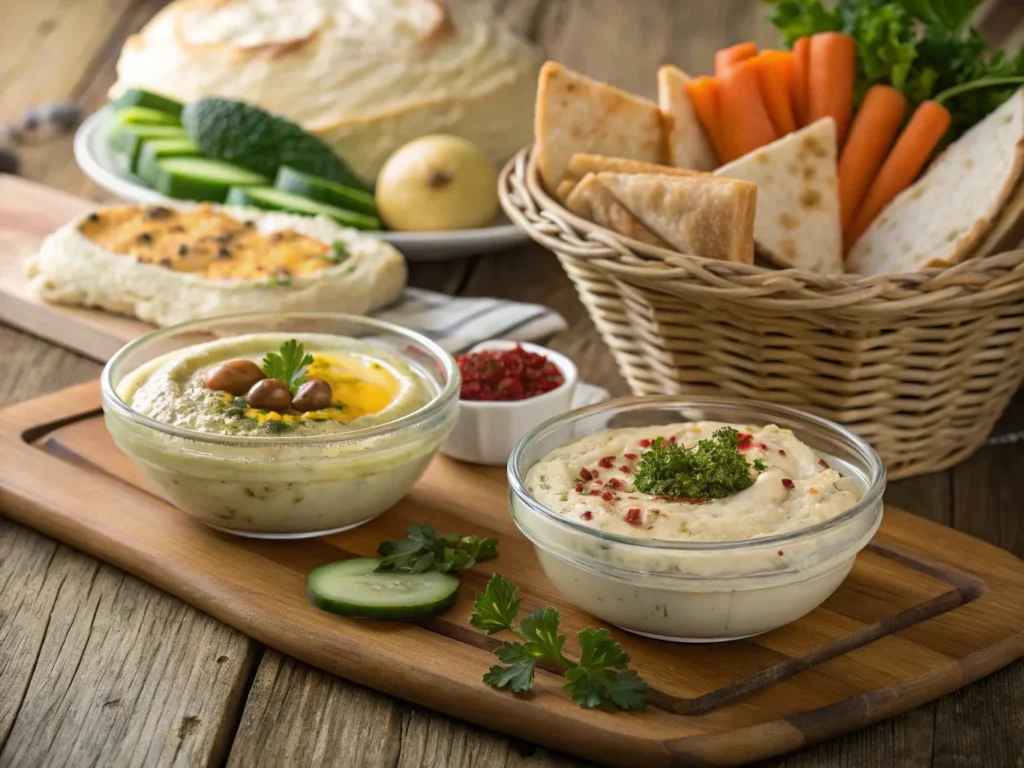
Dips and spreads are the heart of arabic breakfast food recipes. They turn simple morning meals into delightful culinary experiences. Middle eastern morning meals are incomplete without these flavor-packed accompaniments. They bring richness and depth to the breakfast table.
Let’s explore some iconic Middle Eastern dips that will elevate your breakfast spread:
- Muhammara: A vibrant red pepper and walnut dip originating from Aleppo, Syria
- Hummus: The classic chickpea and tahini spread loved across the Arab world
- Labneh: Creamy strained yogurt with a tangy flavor profile
- Baba Ganoush: Smoky roasted eggplant dip with a silky texture
Making these dips requires minimal ingredients but delivers maximum flavor. Muhammara, for example, combines walnuts, roasted red peppers, and pomegranate molasses. This creates a complex taste sensation. Each dip brings unique nutritional benefits and represents the rich culinary heritage of Middle Eastern breakfast traditions.
When preparing these spreads, focus on quality ingredients and traditional techniques. Toasting nuts, using fresh herbs, and balancing spices are key. They help create authentic arabic breakfast food recipes. These recipes capture the essence of middle eastern morning meals.
Sweet Arabic Breakfast Specialties
Arabic breakfast sweets take you on a journey through rich culinary traditions. They offer a perfect balance of flavors that will excite your taste buds. These pastries are a key part of the region’s food heritage.
Exploring sweet Arabic breakfast treats reveals a world of traditional delights. These morning specialties show the creativity and cultural depth of Middle Eastern cuisine.
Traditional Morning Pastries
Atayef is a beloved arabic breakfast sweet, loved during Ramadan. It’s a pancake-like treat that needs careful preparation:
- Preparation time: Approximately 55 minutes
- Key ingredients: Warm water, all-purpose flour, semolina flour
- Unique preparation method involving yeast activation
- Multiple filling options including nuts and cheese
Fruit-Based Breakfast Dishes
Fresh fruits are key in arabic morning pastries. The region’s produce turns simple dishes into amazing culinary experiences. From date-filled treats to fruit compotes, these dishes are both nutritious and flavorful.
Honey and Date Preparations
Honey and date-based sweets are another highlight of arabic breakfast treats. Knafeh, a legendary Lebanese dessert, is a great example:
- Preparation time: Around 40 minutes
- Key ingredients: Phyllo dough, ricotta, mozzarella cheese
- Nutritional profile: Approximately 276 calories per serving
- Can be stored in refrigerator for 3-4 days
These sweet morning treats not only satisfy your sweet tooth. They also connect you to centuries of culinary tradition. Each bite shares a story of cultural richness and culinary artistry.
Savory Arabic Breakfast Dishes
Explore the world of hearty arabic savory breakfast items. They are the heart of morning meals in the Middle East. These dishes are more than just food; they are a rich tradition filled with flavor and nutrition.
Arabic breakfast cuisine is known for its bold and satisfying dishes. Some of the most famous include:
- Foul Medames: A protein-rich fava bean stew loved in Egypt and Lebanon
- Fatteh: A layered dish with crispy bread, chickpeas, and yogurt
- Shakshuka: Eggs poached in a spicy tomato sauce
Let’s look at some tasty preparations to make your morning better:
| Dish | Key Ingredients | Origin |
|---|---|---|
| Foul Medames | Fava beans, olive oil, lemon, garlic | Egypt |
| Fatteh | Bread, chickpeas, yogurt, pine nuts | Levant Region |
| Shakshuka | Eggs, tomatoes, peppers, spices | North Africa |
These arabic breakfast food recipes are more than meals. They are cultural experiences that connect you to centuries of tradition. By making these dishes, you’ll bring the vibrant flavors of the Middle East to your breakfast.
Arabic Breakfast Pastries and Fatayers
Explore the world of arabic morning pastries that add authentic flavors to your breakfast. Fatayers are traditional arabic breakfast food recipes. They show the rich culinary heritage of the Middle East. These savory pastries are more than just a meal – they’re a cultural experience you can create right in your own kitchen.
Fatayers come in several delicious variations, each with a unique taste:
- Spinach Fatayer: A classic filled with fresh spinach and onions
- Cheese Fatayer: Stuffed with Syrian or Feta cheese
- Meat Fatayer: Packed with seasoned ground beef or lamb
- Za’atar Fatayer: Flavored with traditional Middle Eastern spices
When making these arabic morning pastries, precision is key. Each batch makes 24 pastries. You’ll need 2 lbs of flour, 1 envelope of dry yeast, and 2 cups of lukewarm water. Let the dough rise for about 2 hours until it doubles in size.
Baking tips for authentic fatayers include:
- Divide dough into 2-2.5″ diameter balls
- Carefully shape each pastry into a triangular or boat-like form
- Use an egg wash to seal the edges
- Bake at 350°F for 15-20 minutes until lightly browned
By mastering these arabic breakfast food recipes, you’ll bring a taste of Middle Eastern culinary tradition to your morning meal. Each fatayer serves up approximately 196 calories and offers a nutritious start to your day.
Healthy Arabic Morning Meal Ideas
Discover the perfect balance of nutrition and flavor with authentic Arabic breakfast recipes. These meals nourish your body and delight your taste buds. Healthy arabic breakfast ideas celebrate wholesome ingredients and traditional cooking techniques.
Traditional arabic breakfast food recipes offer incredible nutritional benefits. The key is selecting ingredients packed with essential nutrients. Prepare them using methods that preserve their natural goodness.
Nutritious Traditional Options
Arabic breakfast cuisine naturally provides powerful nutritional advantages. Some standout healthy options include:
- Ful medames – a protein-rich fava bean dish
- Labneh – a probiotic-packed yogurt cheese
- Eggs prepared with minimal oil
- Fresh vegetable salads
Modern Healthy Adaptations
Contemporary arabic breakfast food recipes now incorporate innovative approaches. Chefs and home cooks are reimagining classic dishes by:
- Reducing oil quantities
- Adding more vegetables
- Using whole grain breads
- Incorporating lean proteins
Balanced Breakfast Combinations
Creating a nutritionally complete arabic breakfast involves combining different food groups strategically. Your ideal morning meal might include:
- Protein source: Eggs or legumes
- Complex carbohydrates: Whole wheat pita or bulgur
- Healthy fats: Olive oil, nuts, or avocado
- Fresh produce: Tomatoes, cucumbers, herbs
By embracing these healthy arabic breakfast ideas, you’ll enjoy delicious meals. These meals energize and nourish your body throughout the morning.
Essential Arabic Breakfast Beverages
Arabic breakfast drinks are vibrant and key to morning meals in the Middle East. Exploring arabic breakfast drink recipes reveals a rich tradition. These drinks are more than just refreshment; they are cultural experiences that connect people and celebrate centuries-old traditions.
Arabic coffee is the highlight of breakfast drinks. Qahwa, as it’s known, is a symbol of hospitality. It’s made with carefully roasted beans and cardamom, representing warmth and welcome in Arab homes.
- Arabic Coffee (Qahwa): Strong, aromatic, served in small cups
- Mint Tea: Refreshing green or black tea with fresh mint leaves
- Jallab: Sweet fruit syrup drink made from dates and rose water
- Ayran: Yogurt-based savory drink popular in many arabic breakfast food recipes
Tea culture is also important in Arabic breakfast drinks. Black tea with mint is a favorite, balancing strong flavor with cool freshness. Each region adds its own twist to tea, showing local customs and preferences.
For variety, traditional fruit juices like pomegranate and orange are great. These drinks not only quench thirst but also offer nutritional benefits. They are a key part of a balanced Arabic breakfast.
Conclusion
Exploring Arabic breakfast food recipes opens up a world of flavors and traditions. It shows us how food connects us to Middle Eastern culture and hospitality. Dishes like shakshuka and communal platters link us to centuries of history.
Learning the Arabic names for breakfast, like “futoor” or “iftar,” enriches our understanding of these meals. Arabic breakfasts are more than just food; they’re about making connections and sharing moments. They reflect family traditions and regional specialties.
Embarking on a culinary journey through Arabic breakfast invites you to try new recipes and techniques. It brings warmth and joy to your mornings. You’ll discover new flavors and learn about a world that values community and sharing meals.
Every dish you try tells a story of family, culture, and the joy of good food. Your kitchen becomes a place where different traditions meet. It turns simple mornings into special cultural experiences.
FAQ
What is a traditional Arabic breakfast?
A traditional Arabic breakfast includes fresh bread, eggs, and bean dishes. You’ll also find dips, vegetables, and sweet pastries like knafeh. It’s a social meal meant to give you energy for the day.
What are the most common ingredients in Arabic breakfast dishes?
Common ingredients are olive oil, za’atar, and tahini. You’ll also find fava beans, tomatoes, eggs, and fresh herbs. Chickpeas, yogurt, cheese, and spices like cardamom are also used. Bread and fresh produce are key too.
Are Arabic breakfast dishes healthy?
Yes, many Arabic breakfast dishes are healthy. They include high-protein ingredients like beans and eggs. You’ll also find whole grains, vegetables, and healthy fats from olive oil and nuts. Foods like ful medames and shakshuka are nutritious.
What is the difference between breakfast in various Arab countries?
Breakfasts vary by region. Lebanese breakfasts might have more mezze-style spreads. Egyptian breakfasts often feature ful medames. Gulf countries might include more meat. Each region has its own specialties and ways of preparing food.
What are some popular Arabic breakfast beverages?
Popular drinks include Arabic coffee with cardamom and black tea with mint. You’ll also find fresh fruit juices and yogurt-based drinks like ayran. These drinks complement the rich flavors of the morning meals.
How can I make authentic Arabic breakfast at home?
To make authentic Arabic breakfast, start with basic recipes like shakshuka and ful medames. Prepare fresh bread and stock up on key ingredients. Focus on using high-quality ingredients and traditional preparation methods to get the authentic flavors.
What is the Arabic word for breakfast?
In Arabic, breakfast is called “futoor” or “iftar”. “Iftar” is used during Ramadan when breaking the fast. These terms highlight the cultural importance of the morning meal.
Are there vegetarian options in Arabic breakfast?
Yes, there are many vegetarian options. You can find hummus, labneh, ful medames, falafel, and vegetable-filled fatayers. There are also egg dishes, salads, and dips. Arabic cuisine offers a wide range of delicious plant-based choices.
